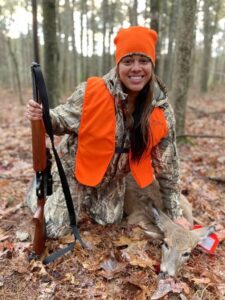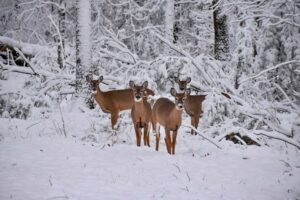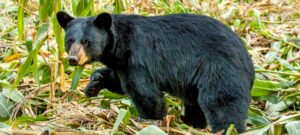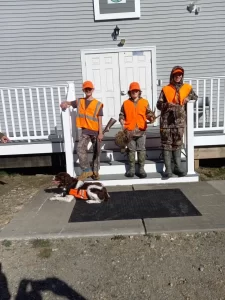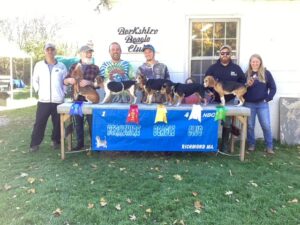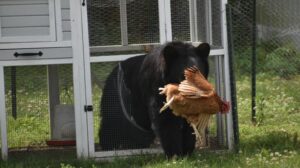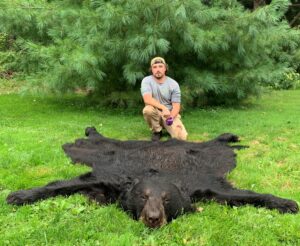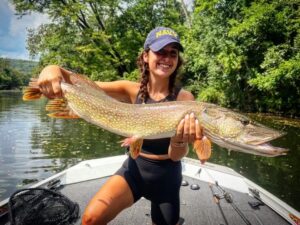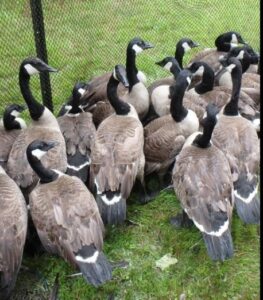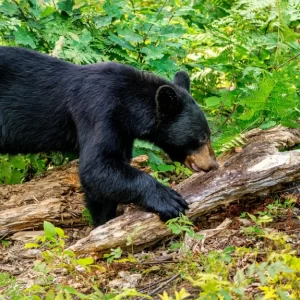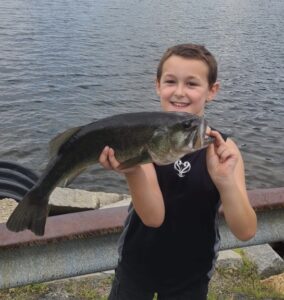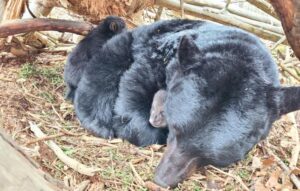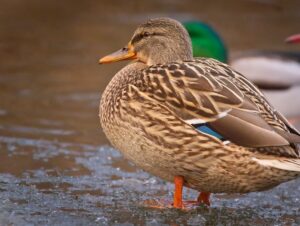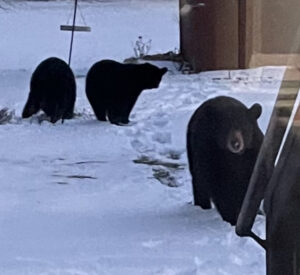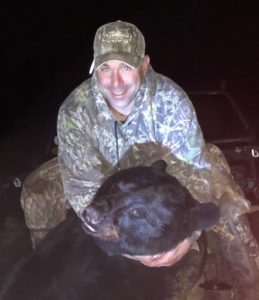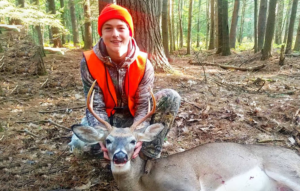The shotgun deer hunting and late bear hunting seasons end this weekend, but the primitive firearm deer hunting season opens on Monday, December 12. If you hunt during that hunting season with a primitive firearm, you must comply with the following information, as listed in the MA Hunting, Fishing and Trapping Regulations:
You must use shoulder-fired muzzleloaders .44 caliber to .775 caliber; barrel length 18 inches or more with only one barrel operational. Inline ignition systems are permitted providing the firearm loads from the muzzle. Single projectile only (no buckshot). Sabot rounds, 209 primers, break/hinge-action muzzleloaders, and scopes are permitted. Powder limited to black powder or black powder substitutes.
A muzzleloader is considered unloaded when the cap or pan powder is removed.
All primitive firearms deer hunters must comply with the 500 square inch blaze orange requirement. A primitive firearm stamp is required.
You may also archery hunt during the primitive firearm season. There are certain regulations which govern archery hunting, so be sure to review them on page 18 of the above-mentioned regulations. A primitive firearm stamp is required.
It is permissible to report your deer harvest online rather than an official check-in station. Remember, it must be reported within 48 hours of harvest.
Here’s hoping the hunters have a safe, enjoyable primitive firearms hunting season and remember, keep your powder dry.
Also, for you hardy waterfowlers, late Canada goose hunting season starts on December 14 and runs until February 15, 2023. The duck hunting season in the Berkshires resumes on December 19 and runs until January 7, 2023.
Be sure to check the 2022-2023 Migratory Game Bird Regulations.
Hunters be careful out there
By now, most people have heard about the deer hunter who had gone missing and was found dead in the woods early Friday, December 2. The body of the man, who has not been identified, was found about 10 a.m., according to state police.
Chesterfield Police Chief Michael Malouin reported that the 64-year-old hunter was found deceased in an area of woods in the town of Goshen. The search began Wednesday evening when he called a friend to tell him he was lost in the woods and that he would stay put.
The search over the heavily wooded area included multiple agencies including search dogs, Chesterfield Fire Department, the Department of Fire Services, Special Operations, Massachusetts State Police, multiple sheriff departments, a drone and The Berkshire Mountain Search and Rescue Team.
Laurie Loisel, Director of Communications at the Northwestern District Attorney’s Office, said the hunter was not from western Massachusetts, but had been staying in a rented hunting cabin in Chesterfield.
Loisel said there were no apparent injuries and no foul play is suspected, and that the office of the Chief Medical Examiner will determine a cause of death. “It appears as though he was out hunting and may have lost his way,” Loisel said.
The Special Emergency Response Team for State Police located the body and an investigation into his death is ongoing. Apparently, a ping from his cellphone was used to identify his general location.
At the time of this writing, the Medical Examiner was determining the cause of death.
Also, recently a Camillus, NY man died when he fell from a tree stand while hunting with his father in Cayuga County, authorities said. Michael S. Rinaldo, 33, died of head injuries when he fell about 18 feet, hitting his head on the way down while hunting, according to Jomo Miller, a spokesperson for the NY State Department of Environmental Conservation.
It was reported that Rinaldo was not wearing a full-body harness, a recommended safety measure when using elevated stands, according to the DEC.
Tree-stand hunters take note: Research shows that falls from elevated stands are caused by: Incorrect placement and use of equipment, mistakes while climbing into or out of the stand, equipment being damaged by exposure to the elements, the hunter’s lack of knowledge about the equipment or excessive wear or stress on the equipment.
Preliminary Shotgun deer hunting results
The harvest totals for the first week of shotgun deer hunting locally were not fully compiled as of Wednesday, December 27 because some deer check stations had not yet submitted their harvest figures. However; we were able to obtain figures from those checked in at the DFW Regional Headquarters in Dalton the first week.
Some 128 deer were weighed and checked in, and some were quite large. For example, an 8-point, 208 lbs. buck was taken in Stockbridge (Lorette); a 7-point, 180 lbs. buck was taken in Middlefield (McCarthy); a 12-point, 178 lbs. buck was taken in Lanesboro (Patriguin); an 8-point, 175 lbs. buck was taken in Sandisfield (Drumm); a 7-point, 174 lbs. buck was taken in Peru (Kirchner) and an 8-point, 170 lbs. buck was taken in Washington (Dermody).
Complete figures were not available from Southern Berkshire County, but we do know of a 10-point 205 lbs. buck that was taken in New Marlboro.
Those were field dressed certified weights. To determine the estimated live weight, multiply field dressed weight by 1.26. For example, that above referenced 208 lbs. buck probably weighed around 262 lbs. on the hoof.
A total of 67 deer were checked in the first week at Ernie’s Auto Sales in North Adams
Becoming an Outdoors-Woman mentored deer hunt
MassWildlife’s Becoming an Outdoors-Woman (BOW) Program offers shooting skills workshops, hunting seminars, and other outdoor skills classes and activities designed for adult women. This fall, MassWildlife offered a deer hunting seminar and a mentored hunt for women who are new to deer hunting. During the seminars, students learned about the lives and habits of white-tailed deer, deer hunting regulations, equipment, and safety, and practiced new skills like shooting, scouting, and recovery. Fifteen women participated in the mentored deer hunt at the Fort Devens Military Area in Lancaster on opening day of shotgun deer season (November 28, 2022), and two women harvested deer.
“I had an amazing time with the BOW program!” said Marilyn Patterson, BOW Program participant. “If there are any females out there that are interested in learning to hunt, I highly recommend it! Thank you to Massachusetts Division of Fisheries and Wildlife!”
MassWildlife is grateful for the many volunteers and mentors who make the BOW Program possible. To learn more about it and sign up to be notified of future workshops, click ontohttps://www.mass.gov/service-details/becoming-an-outdoors-woman-bow.
MassWildlife’s Hunters Share the Harvest Program
MassWildlife’s Hunters Share the Harvest Program provides an opportunity for hunters to donate and share wild game meat like venison with Massachusetts residents in need. Regulated hunting is a safe activity that brings communities together through the sharing of food, skills, and time spent outdoors with nature. A recent study by The Greater Boston Food Bank shows that nearly one-third of adults in Massachusetts are facing food insecurity, a number that has grown during the pandemic.
MassWildlife says that free range, organic venison is a lean, healthy protein with a low carbon footprint that already feeds thousands of licensed hunters and their families across Massachusetts each year. Licensed hunters play an important role in wildlife management in Massachusetts, and now successful hunters can help combat hunger and food insecurity in their communities by donating venison.
This year, there is only one approved meat processor (Haskins Custom Butchering in Hanover) accepting whole-deer donations, and packaged venison will be distributed to those in need through the Massachusetts Military Support Foundation’s Food 4 Vets program. With the support of donors, processing and packaging costs will be covered for deer accepted into the program.
MassWildlife plans to expand donation and distribution locations in the coming years. Meat processors, food pantries, hunger relief agencies, or other organizations who want to participate in MassWildlife’s Hunters Share the Harvest program in the future should contact Martin Feehan, MassWildlife’s Deer and Moose Project Leader, at martin.feehan@mass.gov.
Anyone can help financially support MassWildlife’s Hunters Share the Harvest program with a monetary donation to the Massachusetts Outdoor Heritage Foundation. Your donation will help cover the processing and packaging costs for donated meat. A donation of $25 will provide about 50 servings of meat for families in need.

